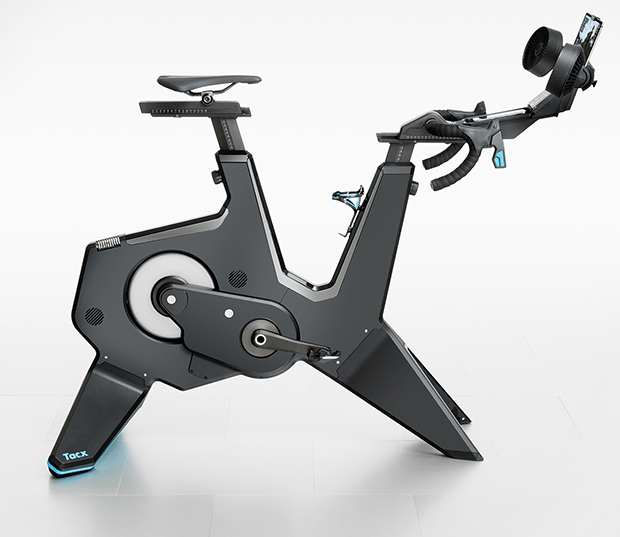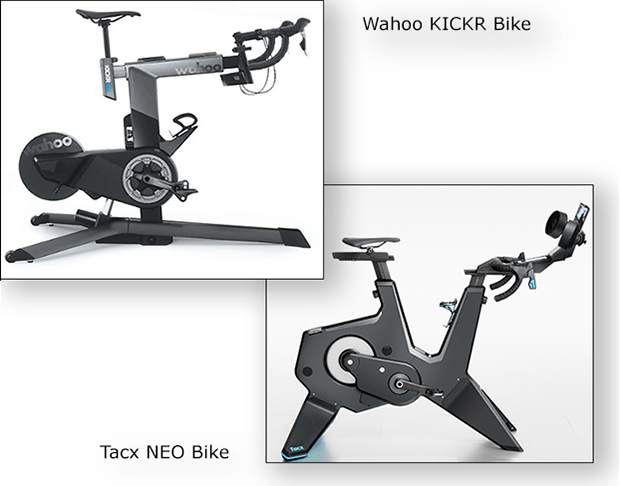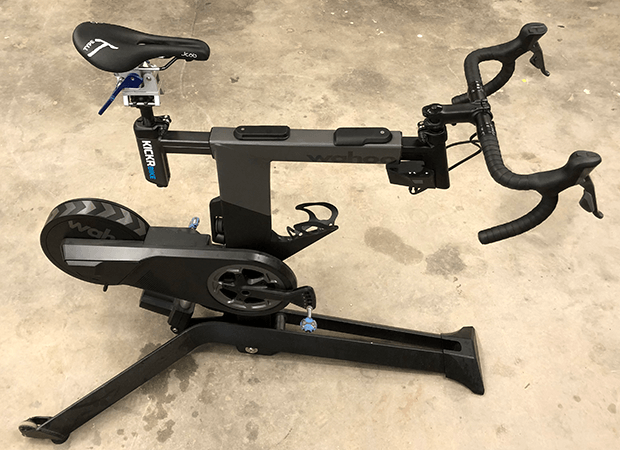StagesBike SB20: Early Impressions
You know how I feel about this class of product: The world’s best smart trainer sits behind any qualifying smart bike. Whatever that top-of-class smart trainer is, it cannot match the utility of either a Tacx NEO Bike or a Wahoo KICKR Bike. Is the StagesBike SB20 a "qualifying smart bike?" Does it deserve to be named alongside the Wahoo and Tacx bikes?
The reasons I exalt smart bikes above smart trainers are several. For starters, your outdoor bike is free to perform the sole duty for which God intended. Second, because a smart bike’s shifting is virtual, there is never a mis-shift, nor a need to adjust the shifting to match the smart bike’s cassette placement (relative to your bike’s derailleur). Third, virtual shifting means almost unlimited gearing options, so, you can ride an 11-25 on a flatter course and a 10-33 on a hillier course, and it’s a lot easier to change a virtual cassette than an actual one. (When you own a virtual bike you own just about every cassette manufactured by any brand.)
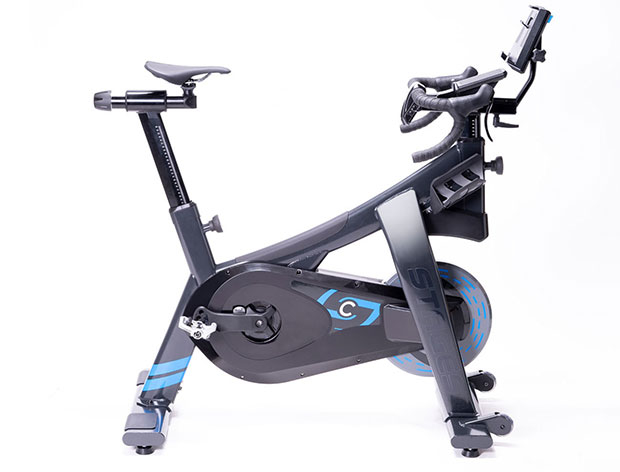
And then there’s what might be the best feature of all: you have unlimited positioning options, if the bike is built to accommodate all the options any human could want. This is important, I think, because it gives you a chance to work on your outdoor position during your indoor training.
I’ve begun riding on the StagesBike SB20 Smart Bike, and this is the feature that is, to me, most compelling about this particular smart bike. I’ve had a lot of saddle time on the Tacx NEO Bike, and on the Wahoo KICKR Bike, and I’ve written about both. Each has its virtues. And I’ll be straight up with you: I didn’t expect the StagesBike to compete with them, for this reason: Stages has not been a participant on the smart trainer category. Wahoo Fitness has. Tacx has. I did not expect Stages to hit the ground, right out of the gate, keeping pace with these other two smart bikes.
In some respects Stages hasn’t kept pace. But there is another lens through one can view this, which is, Stages has a lot more time invested in stationary bikes. Just not smart stationary bikes. Point being, Stages has invested more time in the smokestacky part of this category – the nuts and bolts (and welds and knobs and tubes) than either Tacx or Wahoo.
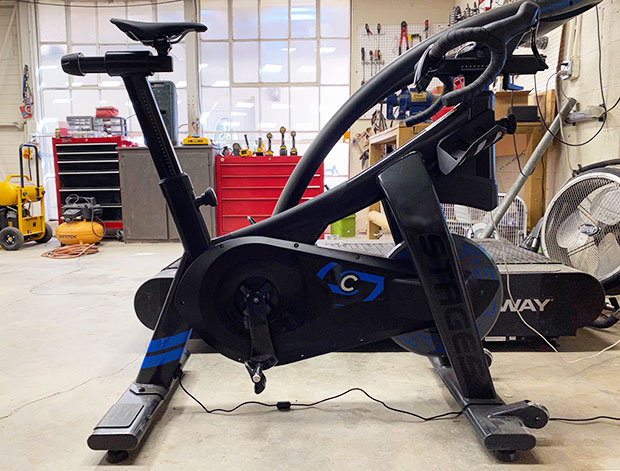
The mistakes Stages has made with this bike I’ll list below. They’re the kind of mistakes you make when you haven’t invested time as a manufacturer in the smart bike category. For all that, though, Stages does certain things better with this bike than either Wahoo Fitness or Tacx. Let me start with this, because you appreciate the value of Stages’ superior features right when you unbox this bike and set it up for riding.
The StagesBike As a Home Fit Tool
If you squint real hard you can see a Serotta Size Cycle here. The back of the bike adjusts in an angular fashion, and the front of the bike adjusts in X/Y axes. I’ll unpack this in a moment, but, as background, I’ve written about the utility of smart bikes as home fit tools. The Wahoo KICKR Bike has a really nifty process for moving your fit coordinates over from your real bike to your smart bike. It’s well thought out. But… there is a language we speak in the bike fit world and I was frankly – and pleasantly – shocked that the StagesBike communicates in this language, as I shall explain.
There are gradient etchings on the seat post, and on the horizontal and vertical slides in the front. The rear gradients are numbered, and seem to me to correlate to the distance from the BB center to the top of the saddle, midway between tip and tail, and that’s great because that’s a coordinate with which I’m very familiar.
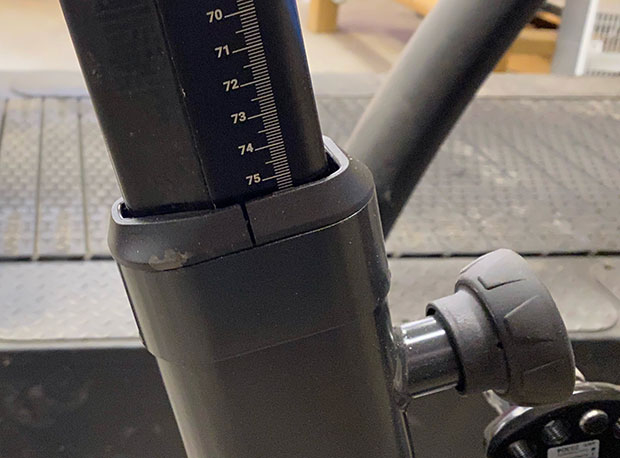
More importantly, the metrics written on the sliding elements on the front of the bike match what we call HX and HY. I’ve written a lot about these metrics in the context of bike fitting.
Fair warning: I'll be in bike fitter [GeekMode] for 5 short paragraphs.
HX stands for “handlebar X” and it’s the "run" from the BB center out to the handlebar clamp (where the stem clamps onto the handlebar). HY is the "rise" from the BB to that spot. If you know these metrics, you know almost everything you need to know about how to buy or set up a bike. We host a calculator on Slowtwitch to aid in this.
For example, here is what I know about the bike I’m now riding on the road: it’s got a 120mm stem, -6° pitch, with 15mm of headset top cap and spacers. The frame has a stack of 580mm and a reach of 400mm. If I go to that calculator and start putting in HX and HY numbers until the output is a frame stack/reach of 580mm/400mm, I eventually settle on HY of 660mm and HX of 500mm. I set up the StagesBike thusly and now my smart bike position matches my road bike position.
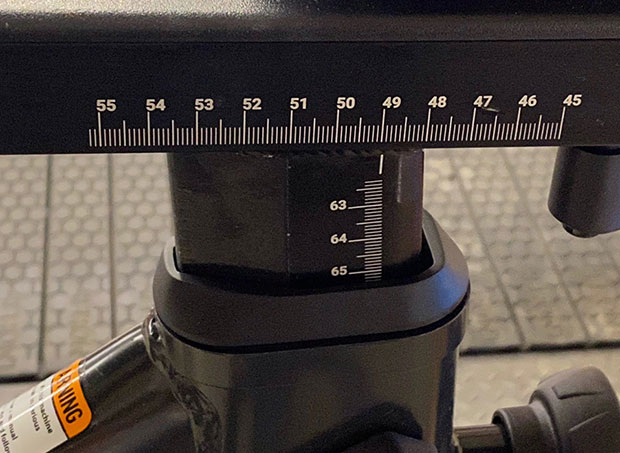
However, let’s say I choose to spend a lot of time on the smart bike and I discover a position riding indoors that I want to translate to my outdoor bike. I'm going to need to make a stem change (for example). What change? I'll use the above calculator differently. The inputs into our calculator are HX and HY of course, and the other metric that we leave unchanged is the frame stack and reach. What sits in between are stem length, stem pitch and any spacers under the stem. Using that calculator, you fiddle with these values until you hit on the right combo that honors your frame’s geometry and gives you the bike position you’ve discovered that you like aboard your StagesBike.
Neither the Wahoo KICKR Bike nor the Tacx NEO Bike works like this. Further, when it comes to the mechanics of making adjustments to the bike, I believe (so far) I like the StagesBike’s clamp and slide hardware the best. I chalk this up to Stages just have a lot more “time in the saddle” on commercial stationary bikes.
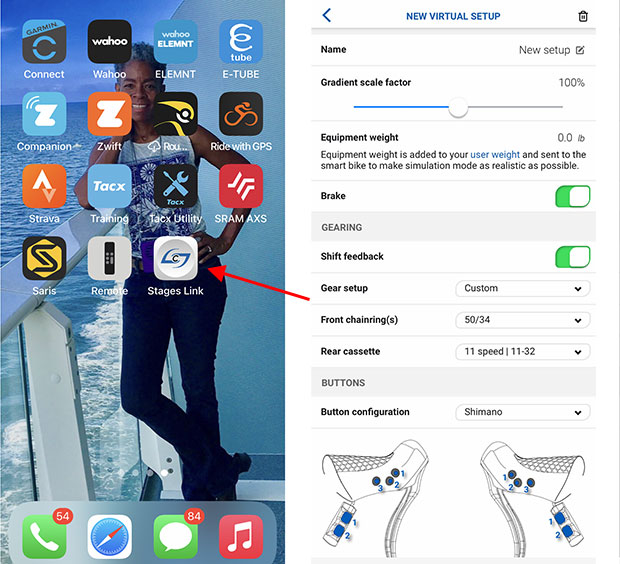
One more geeky thing about fit and adjustment on the StagesBike. I ride with a “Web X” of about 615mm on my road bike. Sorry to throw all these terms as you, but Web X is like HX except instead of to the handlebar clamp it’s to the bend in the hood, where I brace the "web" of my hand against the hood (actually, the run from the BB to the point in between the two hoods). To my calc, the Tacx NEO Bike has a max Web X of 625mm. So, if you’re taller than, say, 6’2”, you might begin to run into a length issue on the NEO Bike, and the The KICKR Bike is likewise rather length challenged for tall riders. The StagesBike stretches out about 50mm longer than a NEO Bike in Web X. If you're tall I'd measure your Web X on your road bike before I made a smart bike purchase decision.
[/GeekMode]
Stages Link
As you might guess, there’s a companion app, just as is offered by Wahoo and Tacx (and you wonder why treadmill companies don’t catch onto this but that's another story). It makes it really easy to configure your smart bike. Wahoo remains the king (in my own experience) at the hardware + associated app ecosystem. I don’t know that Stages makes this obvious, but the first thing you do once you have this bike assembled is to go to Google Play or the Apple App Store and download Stages Link. This is how you configure the gearing, choose which buttons do what on the shifters, and so on. There is a lot more to this app than just this, but that’s for another day.
I consider the shifter ergonomics quite good. Comfortable and lifelike. Tacx, by comparison, have comfortable shifters on the NEO Bike, but they are not like any actual shifters on a bike. The shift buttons on the StagesBike, well, this takes some getting used to. Wahoo has the best process for shifting gears on the KICKR Bike, bar none. What I do like about the buttons on the StagesBike is that they’re programmable, but these buttons (shown below) are just not as ergonomic as what you get on the Wahoo KICKR Bike.

On the issue of shifting, here is probably the single biggest feature omission of this bike. There is no gear display, as in, nowhere on this bike is there a display that tells you what gear you’re in. This is what I mean when I say that this bike benefits from Stages’ deep tenure as a stationary bike maker. This is where Stages suffers from its lack of tenure as a smart trainer brand. Many or most of us really do want to know what gear you’re in when we’re riding.
Now, no biggie (to me) because I solved this pretty easily. I have a drawer full of prior generation handheld phones that are decommissioned and gathering dust. I loaded the Stages Link app on one, and that phone sits on the StagesBike, in a perfect place Stages makes available on the bike. Stages Link has a tab that shows what gear you’re in. That app is always open to this gear display in Stages Link. That phone has become a permanent gear display unit for this bike.
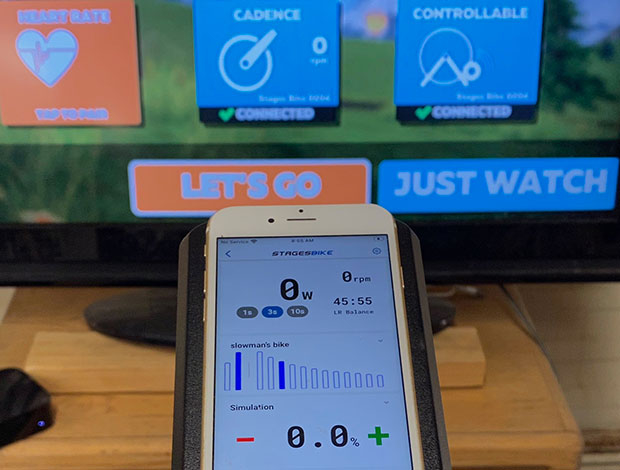
For some of you, the gear display is not important. It’s important to me because the other smart bikes I ride have gear displays, and I therefore have become dependent on them. The negative to my approach – if this feature is important to you – is that it ties up a device if you solve this the way I solved it. The benefit, if you look at the images here, is that this screen in Stages Link gives you a few metrics that you aren’t used to getting in other smart bikes, such as left:right power.
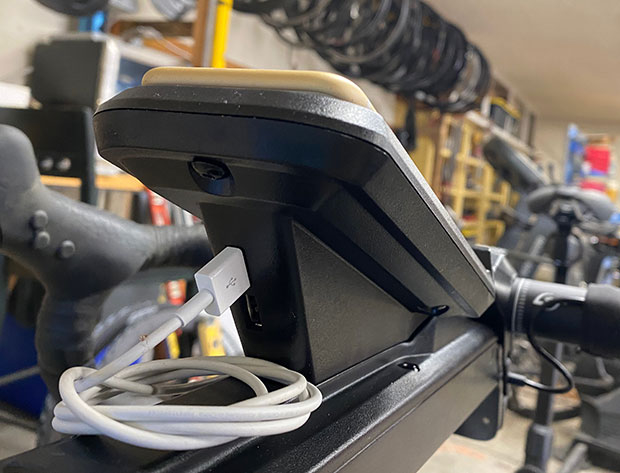
One thing I didn’t notice for the longest while: right in-front-of-and-underneath the phone mount is a pair of USB ports. I had a long cord running from the phone to an outlet in my workshop, until I discovered these ports (above). They’re powered, so, plug in and you’re good! Cool!
One other feature that this bike lacks – or lacked – is an easy way to mount a pedal that has a backside 8mm Allen key as a fixing motif. As I am a confirmed Speedplay guy, this posed a problem, since Wahoo Speedplay did away with wrench flats on the new pedals. This, again, speaks to the milieu in which Stages lived. Probably not a lot of call for this in the stationary bikes it made in the past. However, this came up, and Stages has solved this with an included 8mm Allen with a very short extension after the elbow. (As you see.)
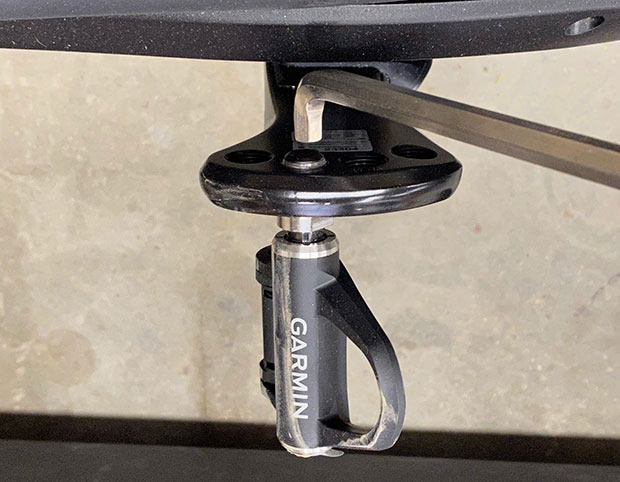
Each of the 3 Smart Bike brands have their advantages. Wahoo Fitness just overwhelms you with features, most notably incline (and that’s a biggie), and it’s got steering (this is one downside to smart bikes: if you don’t have steering programmed into the buttons (as does the KICKR Bike), you can’t get it, because the bike has no front wheel to slot into an Elite Steerzo Smart). Tacx is known for its accuracy and road feel, and incorporates road feel elements (gravel, offroad, wooden bridges, you can feel it all on a Tacx). Stages' strengths are listed here.
Errata
The StagesBike supports all the usual standards – ANT+ and USB – and all the apps and platforms you’d be interested in (Zwift, Rouvy, FulGaz, you can see the full list on the Stages page for this product). It can generate up to and beyond 2,000 watts of resistance, which is probably double or even triple what you’ll need, and I found the flywheel and rideability not exactly the same, but on par (once you get familiar with it) with the other bikes in its competitive set.
Notably, the StagesBike is very stable, yet very portable, easy to wheel around your pain cave (pick up one end, wheelbarrow style). This is probably another benefit of having a lot of stationary bike experience. I used to think the Tacx NEO Bike was the Rock of Gibralter, as smart bikes go. The StagesBike is equally rocklike. But it is as easy to move around as the KICKR Bike (the Tacx NEO Bike is moveable, but really would prefer to just stay where it is).
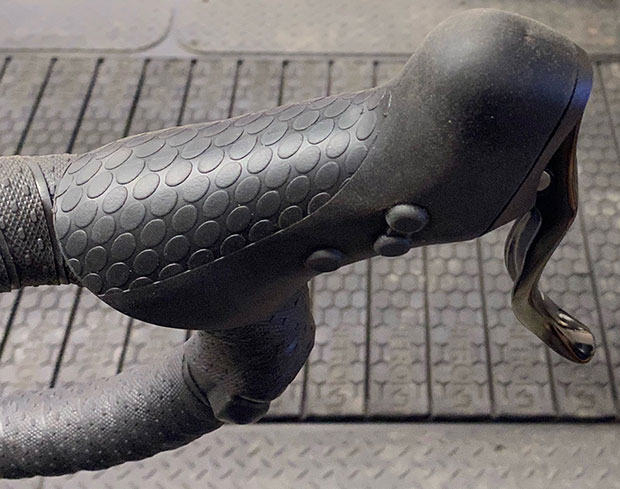
It uses the same adjustable crank motif as does Wahoo's KICKR Bike, and which is better than the method Tacx uses. For those of you who’re bike fitters, is this a commercial fit bike? Well… it could be. The way you execute changes in fit coordinates is barbaric compared to today’s fit bikes (as are the methods used by every smart bike). What are wanted are linear actuators controlled by handwheels (or motors). Nobody does this in the smart bike world. However, fit bikes are barbaric in the resistance units they use. Nobody has, so far, put the mechanical tech of a fit bike together with the resistance unit of a smart bike.
Finally, the StagesBike it’s less expensive than these other smart bikes. The Stages Bike is $2,999 against $3,199 for the Tacx NEO Bike and $3,499 for the Wahoo KICKR Bike. Here is the StagesBike SB20 at MyBikeShop.
I’ll write more about this bike as I get to know it better. Next up is an investigation into the accuracy of this bike. As you might guess, this bike functions using Stages’ power meter as the unit determining the resistance applied to the drivetrain. I’ll look at how this compares to the resistance generated by the other smart bikes.


